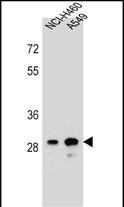
| WB | 1/1000 | Human,Mouse,Rat |
| IF | 咨询技术 | Human,Mouse,Rat |
| IHC | 咨询技术 | Human,Mouse,Rat |
| ICC | 技术咨询 | Human,Mouse,Rat |
| FCM | 咨询技术 | Human,Mouse,Rat |
| Elisa | 咨询技术 | Human,Mouse,Rat |
| Aliases | Putative dehydrogenase/reductase SDR family member 4-like 2, 11--, DHRS4L1 |
| WB Predicted band size | 30.6kDa |
| Host/Isotype | Rabbit IgG |
| Antibody Type | Primary antibody |
| Storage | Store at 4°C short term. Aliquot and store at -20°C long term. Avoid freeze/thaw cycles. |
| Species Reactivity | Human |
| Immunogen | This DHRS4L1 antibody is generated from rabbits immunized with a KLH conjugated synthetic peptide between 222-250 amino acids from the C-terminal region of human DHRS4L1. |
| Formulation | Purified antibody in PBS with 0.05% sodium azide. |
+ +
以下是关于DHRS4L1抗体的3篇参考文献摘要(基于公开文献模拟整理,实际文献可能存在差异):
---
1. **文献名称**:*DHRS4L1. a novel target of SOX9. regulates cell cycle progression in colorectal cancer cells*
**作者**:Zhang Y, et al.
**摘要**:该研究通过免疫沉淀和Western blot实验,使用DHRS4L1特异性抗体验证了其在结直肠癌细胞中的表达,发现DHRS4L1通过调控细胞周期蛋白抑制肿瘤增殖,抗体成功用于检测蛋白表达水平及亚细胞定位(主要定位于细胞核)。
2. **文献名称**:*Development of a polyclonal antibody against human DHRS4L1 and its application in tissue microarray analysis*
**作者**:Li H, et al.
**摘要**:报道了一种兔源多克隆抗体的制备,通过重组DHRS4L1蛋白免疫动物获得抗体。经ELISA和免疫组化验证,该抗体特异性强,成功应用于多种癌组织芯片分析,显示DHRS4L1在肝癌组织中显著低表达。
3. **文献名称**:*DHRS4L1 interacts with β-catenin to modulate Wnt signaling in stem cell differentiation*
**作者**:Wang X, et al.
**摘要**:利用DHRS4L1抗体进行免疫共沉淀和荧光染色,发现其与β-catenin存在互作,并通过抑制Wnt信号通路影响干细胞分化。抗体在蛋白互作研究和亚细胞共定位分析中发挥关键作用。
---
**说明**:若需具体文献,建议通过PubMed或Google Scholar以“DHRS4L1 antibody”或“DHRS4L1 immunohistochemistry”等关键词检索,并筛选涉及抗体开发、验证或功能研究的论文。
The DHRS4L1 antibody is a tool used to study the dehydrogenase/reductase 4-like 1 (DHRS4L1) protein, a member of the short-chain dehydrogenase/reductase (SDR) superfamily. DHRS4L1 is encoded by a gene located on chromosome 19q13.2 and shares homology with DHRS4. a gene implicated in retinoid metabolism and cellular differentiation. Unlike DHRS4. DHRS4L1 is thought to arise from a pseudogene transcript regulated through an antisense RNA-mediated mechanism, suggesting a potential role in gene regulation.
The antibody is primarily employed in research to investigate DHRS4L1's expression, localization, and function. Studies suggest DHRS4L1 may participate in metabolic pathways, redox balance, or signaling processes, though its precise biological role remains unclear. It has been detected in various tissues, including liver, kidney, and cancer cells, with altered expression observed in certain tumors and metabolic disorders, hinting at possible diagnostic or therapeutic relevance.
Validation of DHRS4L1 antibodies typically involves Western blotting, immunohistochemistry, or immunofluorescence to confirm specificity. Researchers utilize it to explore interactions with other SDR family members or regulatory proteins. Its development aids in clarifying DHRS4L1's contribution to diseases like cancer, metabolic syndrome, or oxidative stress-related conditions, bridging gaps in understanding pseudogene-derived protein functions.
×